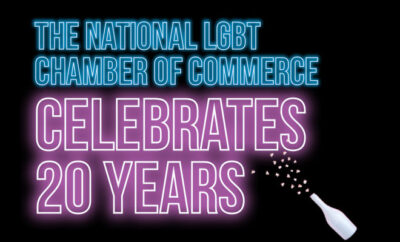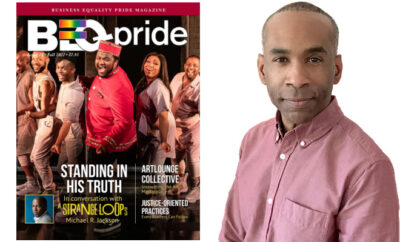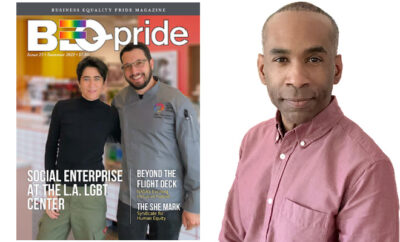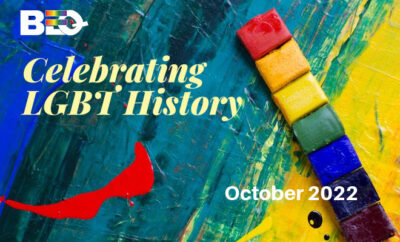
Public Square
Beyond the Flight Deck
Beyond the Flight Deck: NASA’s Exciting Inclusive Future
By KJ Ward
Astronaut Jessica Watkins made headlines in April following the announcement that she would be the first Black woman to serve a long-duration mission on the International Space Station. This news is certainly an example of growing equity in space exploration, but the National Aeronautics and Space Administration’s (NASA) commitment to access and opportunity extends well beyond this high-profile example.
So much happens beyond the flight deck at NASA to make its earth and space research and expeditions possible. NASA partners with an incredibly large number of professionals, companies, and institutions in the delivery of products and services from space-systems equipment and R&D to facilities and logistics to custodial and food services. This range of procured services amounts to 80% of NASA’s $25 billion budget, and BEQ Pride had the opportunity to speak with an executive who is one of only three signatory authorities that can execute procurement policies and procedures on behalf of the United States Federal Government.
Karla Smith Jackson is Assistant Administrator for Procurement, Senior Procurement Executive, and Deputy Chief Acquisition Officer for NASA. She shared with BEQ Pride how NASA’s Equity Action Plan (released in April 2022) is helping the organization rethink and reshape the landscape of the administration’s contracts and partnerships by enabling “the agency to track progress toward improved, equity, inclusion, and accessibility both internally and externally….”
REACHING LGBTQ+ TALENT
Along with women, minority, and veteran-focused businesses and research institutions, the LGBTQ+ community is one of the underrepresented and underserved communities that Jackson is committed to connecting with, but she shared with BEQ Pride that making inroads with this community has presented unique challenges, particularly the seeming invisibility of LGBTQ+ talent:
“We know that LGBTQ+ talent is out there, but sometimes that community is embedded within a larger community,” Jackson said. “Much of our outreach has focused on looking to professional associations, such as engineering or technical and science organizations, but that isn’t necessarily a direct line to LGBTQ+ individuals or companies. We are cultivating relationships with Historically Black Colleges and Universities and Hispanic Serving Institutions, but there aren’t LGBTQ+ universities.”
For Jackson, this just means a more creative and concerted effort – making connections with organizations (including the Business Equality Network and BEQ Pride Magazine) with links to the growing number of networks of LGBTQ students, researchers, and businesses that a traditional approach to locating talent through professional associations and universities has not revealed.
Diversity is the Fuel of Innovation
While this particular initiative is new, Jackson made clear that NASA has a long history of working toward greater inclusion. “The very ethos of NASA is diversity and inclusion,” she said. “Inclusion is one of the agency’s five core values, and we were doing this work before it was popular.”
Jackson also made clear that inclusion is not just the right thing to do but a strategic imperative for NASA as “the ability to tap into different talents with different perspectives and experiences is how you innovate. This country is made up of a rich mix of people, and tapping into that richness is where the innovation comes from.”
“The one thing that we know, is that in order for us to achieve our goals – to get to the moon and to Mars – we’ve got to innovate. How do you generate new ideas if you’re only talking to the same people you’ve always talked to?”
Leveraging the Full Reach of Current Partnerships
One metric of NASA’s success will be an increasingly diverse vendor base, but Jackson also described a strategy of leveraging current partnerships as a way to create an even wider-reaching, ripple effect of inclusion. “We’re trying to hold our large, traditional aerospace partners accountable to our vision of inclusion by requiring them to develop Diversity, Equity and Inclusion plans. We want them to have these plans both within their companies and within their subcontractor and vendor communities as well, identifying businesses from underserved communities.”
Jackson added, “We want them to identify targets for spend, and then we’re going to hold them accountable in a surveillance posture to make sure that they actually do spend that money and they bring those companies along.”
It doesn’t seem that compliance is anything that will have to be forced because, as Jackson notes, these companies are also acutely aware of the value of inclusion and the unsustainability of the status quo. “[Our traditional partners] are energized around the opportunity to see and get new talent. They understand that they need to open their aperture to get a wider variety, or else they’re just trading horses with what they already know.”
Addressing Structural Barriers
One of the ways that homogeneity in systems gets entrenched is that only larger companies seem well positioned to carry out the scope or scale of many NASA contracts, and large businesses tend not to be helmed by leaders from underrepresented groups. To address this barrier, NASA got creative with their Equity Action Plan, breaking down the deliverables of what would traditionally be a single contract into component parts. “If a smaller company can’t do the entirety of a [project] requirement, there’s a niche piece,” Jackson said of a strategy that NASA informally refers to as “matchmaking.”
Another structural barrier is the complexity of processes like bidding that longstanding NASA contractors are accustomed to but that are foreign (and daunting) to prospective businesses that could offer significant value but are newer to the world of contracting with large Federal agencies. “We want to educate them about federal procurement, so the process itself isn’t a barrier.”
A “Personal Passion”
Jackson reiterated that NASA’s comprehensive commitment to inclusion is a necessary investment in the future of science and technology. “We need to make long lasting, enduring impact, where everybody is included,” she said. “This is how we move forward.”
Jackson’s engagement with this effort, however, goes far beyond the role of a senior procurement executive ensuring that an agency maximizes its innovation opportunity. This work is rooted in her own experience of being on both sides of the access equation and her commitment to ensuring that people from communities that haven’t traditionally had seats at the table get opportunities to bring their talents and their full selves to a forward-thinking organization.
The child of an African American U.S. Army Colonel who went on to college at a predominately white institution, Jackson spent much of her life in spaces where she was the only Black person. It wasn’t until transferring to Hampton University, an historically Black university, that she had the experience of being among the majority and what that entailed.
“What I experienced there was accessibility of information and inclusion without having to explain myself,” she said. “There was a familiarity and a connection with people that were like me, that I’d never experienced before.”
As a professional, Jackson would certainly find herself back in spaces where she was “the only one” but having experienced what full inclusion could actually look and feel like, she would commit to opening doors for others and “make it [her] business to connect with the LGBTQ community.”
“For the first few years of my career [in government] I struggled to find a voice. Not only was I often the only minority, I was generally the only woman. Then I had an opportunity to go out and recruit small businesses for innovative research proposals and business technology transformation proposals. I ended up connecting with those folks because they were also looking for a place,” she said.
“I was now in the position to reach out and remove some barriers and knock down some walls for others to be able to enter.”
NASA’s Artemis I Lunar Mission is set to land the first woman and and the first person of color on the moon, and NASA’s Equity Action Plan is set to ensure that the rich diversity of the nation finds its way not only onto the flight deck of a NASA spacecraft but into every activity of the agency. Of her own planned 2022 space mission, Jessica Watkins (also on the Artemis I team) said, “This is a step in the direction of a very exciting future.” I think Karla Smith Jackson would agree that this sentiment applies to the Equity Action Plan as well.
NASA’S EQUITY ACTION PLAN SNAPSHOT
- Equity in Procurements and Contracts
Increasing integration and utilization of contractors and businesses from underserved communities and expanding equity in NASA’s procurement process
- Equity in Grants and Cooperative Agreements
Enhancing grants and cooperative agreements to advance opportunities, access, and representation for underserved communities
- Equity in Climate Data Accessibility and Environmental Justice
Leveraging Earth Science and socioeconomic data to help mitigate environmental challenges in underserved communities
- Equity in Civil Rights Compliance and Accessibility to Limited English Populations
Advancing external civil rights compliance and expanding access to limited English proficient populations within underserved communities
For more information on NASA’s Equity Action Plan, visit nasa.gov/mission-equity.
For more information on how to certify your LGBT-owned business visit nglcc.org/lgbtbe-certification/

KJ Ward is a freedom fighter with a love of language and an appreciation of the power of the written word. Earlier in his career he worked as a case manager for the State of Hawaii Department of Human Services and as the director of Boston GLASS, a supportive services and advocacy program for LGBTQ youth. KJ also worked for several years as a communications specialist for McKinsey & Company in Germany.
Today, KJ partners with a small group of clients in service of their communications strategy and organizational development needs. He is a proud and active member of both the board of directors of Gender Spectrum and the California Coalition for Women Prisoners, and from time to time he publishes his own writing. KJ is also a registered yoga teacher, committed to bringing this practice of individual and community liberation to those whose access to it has been limited.
KJ earned a bachelor’s degree from Dartmouth College and a master’s degree in developmental psychology from Harvard University.
Business Equality Pride (BEQPride) is the first publication from the BEQ family of national print and digital magazines exclusively addressing the needs of LGBTQ small-to-medium sized businesses, entrepreneurs and professionals.

















0 comments